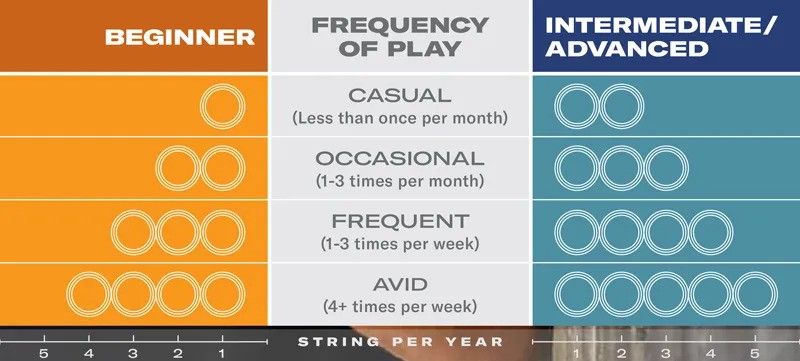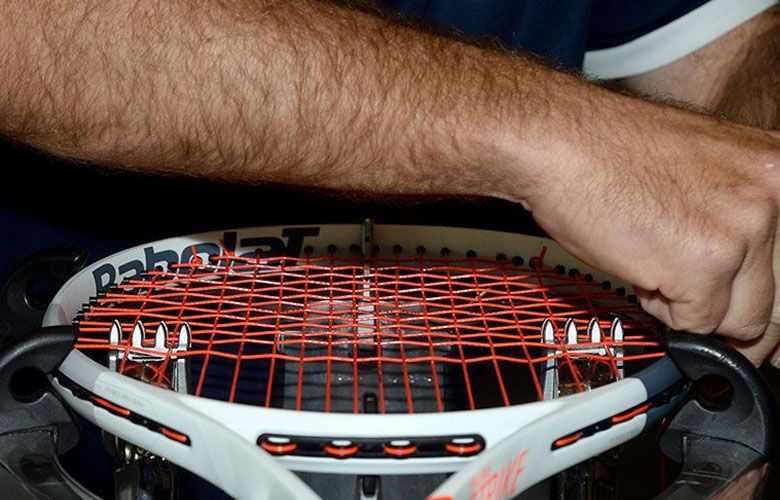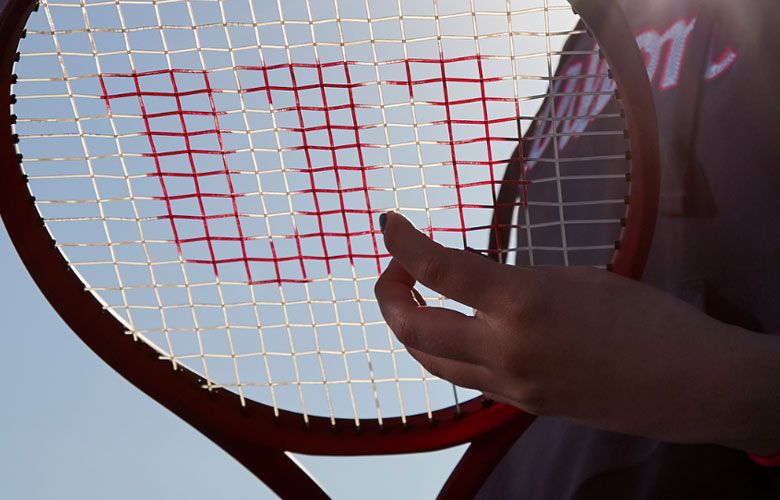How often is it necessary to restring my tennis racquet?

Restringing your tennis racquet is an essential aspect of maintaining optimal performance and feel during play. The frequency at which you should restring your racquet can vary based on several factors, including your playing style, how often you play, and the type of strings you use. Here’s a detailed breakdown:
Tennis Strings: How often is it necessary to restring my tennis racquet?
Your strings can significantly affect your performance, just like the racquet itself. A common guideline has traditionally suggested restringing your tennis racquet as many times a year as you play in a week (for example, if you play once a week, you would restring once a year). However, this approach doesn’t account for players who play less frequently and is generally not sufficient for optimal performance. To provide a better framework, here’s a basic guide outlining the minimum number of times you should restring your racquet each year:

Frequency of Play
Competitive Players: If you play regularly—typically several times a week—it's recommended to restring your racquet every 4 to 6 weeks. This frequency helps maintain consistent tension and ensures the strings perform optimally.
Casual Players: For those who play less frequently, such as once a week or every couple of weeks, restringing every 2 to 3 months may be sufficient. However, keep an eye on the condition of your strings.
Playing Style and String Type
Power Hitters: Players who generate a lot of power and spin may find they break strings more often. Such players might need to restring after every 10 to 15 hours of play.
Control Players: Those who focus on control and placement may find their strings last longer. If you’re not breaking strings but notice a loss of feel, consider restringing to maintain performance.
String Material: The type of strings also plays a role in how often you should restring. Natural gut strings may lose tension faster than synthetic options, while polyester strings are more durable but may still lose playability over time.
Performance and Feel
Loss of Tension: Strings lose tension naturally over time, impacting your control and power. If you notice a decrease in your racquet’s responsiveness or feel, it might be time to restring, even if the strings haven’t broken.
String Fraying or Damage: Inspect your strings regularly. If you see fraying, wear, or signs of damage, consider restringing, regardless of how long it has been since your last restringing.
General Guidelines
Restringing After a Set Period: A good rule of thumb is to restring your racquet as often as you play each week. For example, if you play three times a week, aim to restring every three weeks.
Set a Schedule: If you play frequently or are training for a tournament, establishing a regular restringing schedule can help you maintain optimal performance.
Tennis String Theory: What other factors should I consider for re-stringing?
When it comes to re-stringing your tennis racquet, several factors beyond just the frequency of play should be taken into account to ensure optimal performance. Here are some key considerations:

- String Material: Different materials, such as natural gut, synthetic gut, polyester, and multifilament, have varying durability and playability. Natural gut offers excellent feel but may require more frequent restringing, while polyester strings are often more durable and can withstand harder hits.
- String Gauge: Thinner strings (higher gauge numbers) provide more feel and playability but can break more easily, necessitating more frequent restringing. Thicker strings (lower gauge numbers) offer more durability but might sacrifice some touch.
- Playing Style: Your style of play influences how quickly your strings wear out. If you're a hard hitter or frequently use topspin, you may need to restring more often than someone who plays with a softer touch.
- Weather Conditions: Extreme temperatures and humidity can affect string tension and durability. For example, high humidity can lead to tension loss in natural gut strings, while cold weather can make polyester strings stiffer.
- Match Play vs. Practice: If you're playing in tournaments or competitive matches, you may want to restring more frequently for optimal performance compared to casual practice sessions.
- Tension Maintenance: As strings lose tension over time, the feel and responsiveness of your racquet can change. If you notice a decline in performance or feel, it might be time to restring, regardless of how long it’s been since your last restringing.
- Personal Preference: Ultimately, your comfort and preferences play a crucial role. Some players prefer fresh strings for that crisp feel, while others might be fine with older strings as they break in.
- Frequency of Play: While the traditional guideline is to restring as often as you play in a week, assess how you feel about your string's performance. If you notice a decline in playability, it may be time to restring, regardless of your playing frequency.
How do I know when it's time to restring my tennis racquet?
Here’s how to determine when it’s time to restring your tennis racquet:

- Visible Damage: Inspect your strings for fraying, broken strands, or wear. Any noticeable damage is a clear sign that it’s time to restring.
- Loss of Tension: Strings lose tension over time, affecting the racquet’s responsiveness. If your shots feel less controlled or powerful, it may be time for new strings.
- Change in Sound: Listen for changes in the sound when the ball makes contact with the strings. If the sound is dull or lacks that familiar “pop,” it could indicate worn strings.
- Comfort Issues: If you experience discomfort or pain while playing—particularly in your arm or elbow—it may be due to old strings. Fresh strings can help reduce vibrations and enhance comfort.
- Frequency of Play: A common rule of thumb is to restring your racquet as often as you play in a week. For instance, if you play once a week, consider restringing once a year, but adjust this based on your play intensity and string type.
- Performance Decline: If you notice a drop in your performance—such as less spin, control, or power—worn strings could be the culprit. Restringing can help restore your confidence and game.
- Time Since Last Restring: Even if you haven’t played much, consider restringing every 6 to 12 months, especially if you use natural gut strings or play frequently.
- String Type: Different string materials have varying lifespans. Natural gut strings, for example, wear out faster than polyester strings, so be more vigilant if you use them.
- By paying attention to these factors, you can make informed decisions about when to restring your tennis racquet, ensuring you maintain the best possible performance on the court.
I am breaking tennis racquet strings too often. What should I do?
If you’re breaking tennis racquet strings too often, consider the following strategies to reduce string breakage:

- Choose Durable Strings: Switch to more durable string types, such as polyester or Kevlar, which are designed to withstand heavy use. These materials tend to be stiffer and can handle the impact better than softer strings.
- Adjust String Tension: Lowering the string tension can help absorb shock and reduce breakage. While this may reduce control slightly, it can improve comfort and durability.
- Hybrid Stringing: Consider using a hybrid setup, where you use a durable string for the mains (vertical strings) and a softer string for the crosses (horizontal strings). This combination can balance durability and playability.
- Inspect Your Technique: Evaluate your playing style and technique. Overhitting, poor timing, or hitting the ball off-center can contribute to increased stress on the strings. Working with a coach may help improve your technique.
- Regular Restringing: If you’re consistently breaking strings, it may be beneficial to restring more frequently. This can help maintain tension and playability, reducing the chances of breakage.
- Use String Savers: These small devices can be added to your string bed to help reduce friction between the strings, extending their lifespan.
- Change Your Playing Surface: If you primarily play on hard courts, consider playing on softer surfaces (like clay) when possible, as they can be easier on your strings.
- Check Your Equipment: Make sure your racquet is in good condition. A cracked frame or worn grommets can lead to increased stress on the strings, causing them to break more frequently.
- By implementing these strategies, you can help prolong the life of your tennis strings and improve your overall playing experience.
I have multiple racquets. I primarily use one and have the other as a back-up so it doesn’t get played with as much. Do I need to re-string both every time?
You don’t necessarily need to restring both racquets every time you restring your primary one, especially if the backup is not used as often. However, here are a few tips to consider:
- Matching Tension: If you plan to use your backup racquet, it’s a good idea to restring it with the same type and tension of strings as your primary racquet. This ensures consistency in feel and performance when you switch between them.
- Check Condition: Regularly inspect the strings on your backup racquet. If they show signs of wear, fraying, or loss of tension, it may be time to restring it, even if it hasn’t been played with much.
- Time Between Restrings: Strings can lose tension and performance over time, even if not used. If your primary racquet is restrung frequently, consider restringing the backup racquet periodically as well to keep it ready for play.
- Personal Preference: Some players prefer to have both racquets strung and ready to go. If you anticipate using your backup more in the future, it may be worth restringing it along with your primary racquet.
Can I re-string my tennis racquet on my own?
Yes, you can restring your tennis racquet on your own, but it requires the right equipment and practice. You'll need a stringing machine, which ranges from basic to advanced models, depending on your preference and budget. For restringing, you must secure the racquet in the machine, pull each main (vertical) and cross (horizontal) string to your desired tension, and use clamps to hold the tension until you tie knots to finish the job.
If you’re new to stringing, there’s a learning curve involved, as it takes practice to get comfortable with the techniques and patterns specific to your racquet. Many players find it rewarding to learn, as it offers flexibility in string choice and tension adjustments, as well as cost savings over time.
How our Stringing Service works?
Send Us Your Racquet: Ship your racquet to us, and our certified string technicians will handle the rest.
Customized Stringing: Our experts will string your racquet to your specified tension and style within 48 hours.
Free Return Shipping: Once complete, we’ll ship your racquet back to you at no additional cost.
Cost: $24.95 + cost of string.
Frequent play causes tension loss over time, affecting control and consistency in your game. Our Midwest Racquet Sports racquet service experts, certified as Master Racquet Technicians (MRT), provide precise, customized stringing services to restore performance to any racquet, no matter where it was purchased.
To keep your racquet at peak playability, a good rule of thumb is to restring as many times per year as you play weekly.
At what tension should I have my racquet strung?
The ideal tension for your tennis racquet depends on your playing style, skill level, and preference for power or control. Here’s a basic guide to help you find the right string tension:

Lower Tension (40-50 lbs)
Benefits: More power, a softer feel, and increased comfort, which is often easier on the arm.
Who It’s For: Beginners, recreational players, and those seeking extra power and comfort in their shots.
Higher Tension (50-65 lbs)
Benefits: Greater control, improved precision, and a crisper feel.
Who It’s For: Intermediate to advanced players who prefer control over power and can consistently generate their own power in shots.
Hybrid Tensions (Mix of Low & High)
Benefits: Customizable balance of power and control, typically with a different tension on the main and cross strings.
Who It’s For: Players who want to blend power and control based on specific string setups and personal feel.
Considerations for Specific Play Styles
Heavy Spin: Lower tensions can help generate spin but may sacrifice control, so experiment within the 45-55 lbs range.
Powerful Baseliners: Lower or mid-range tensions can boost power.
Net Play & Control-Focused Players: Higher tension allows for better precision at the net.
Ultimately, it’s best to start within the manufacturer’s recommended tension range and adjust as needed.
How to Order?
Follow these simple steps to get your racquet restrung and back to peak condition:
Select Your Racquet Brand: Choose the brand of racquet you'll be sending to us, or opt for Hybrid stringing if preferred.
Choose Your String: Pick from our wide selection of strings suited to your playing style.
Set Your Tension: Specify your desired tension for optimal play.
Add to Cart: Add the stringing service to your cart, and head to checkout.
Add Special Instructions: At checkout, include any additional notes or special requests, such as string tension details.
Packing Tips:We recommend packing your racquet securely in a sturdy box (our shipping boxes are 30" x 12" x 2") with sufficient padding to avoid damage. Ship with a trackable method for added assurance.
Ship to:
Midwest Racquet Sports
Attn: Stringing Department
11613 Reading Rd
Cincinnati, OH 45241
Questions? Call us at 800-334-4580.
